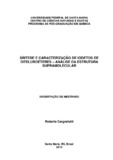| dc.creator | Cargnelutti, Roberta | |
| dc.date.accessioned | 2012-09-12 | |
| dc.date.available | 2012-09-12 | |
| dc.date.issued | 2012-02-28 | |
| dc.identifier.citation | CARGNELUTTI, Roberta. Synthesis and characterization of ditelluroethers iodides Analysis of supramolecular structure. 2012. 107 f. Dissertação (Mestrado em Química) - Universidade Federal de Santa Maria, Santa Maria, 2012. | por |
| dc.identifier.uri | http://repositorio.ufsm.br/handle/1/10496 | |
| dc.description.abstract | This work describes the synthesis and characterization of thirteen new compounds belonging to the class of ditelluroethers iodides. The starting materials (ditelluroethers) were synthesized by a method few mentioned in the literature for the synthesis of this class of compounds. This methodology proved to be efficient once that ten new ditelluroethers were synthesized in satisfactory yields. Of these thirteen synthesized compounds, six had their structures determined by X-ray diffraction. From the structural analysis of these different ditelluroethers iodides we can conclude that the organization of the crystalline packing and the formation of the supramolecular assembling may vary with the carbon chain size between the tellurium atoms, aryl groups bond to the tellurium atom and the amount of molecular iodine used in the reaction. To ditelluroethers iodides of type [(PhTeI2)2(μ-CH2)] (1) with the participation of secondary bonds could be observed the formation of one-dimensional pseudo polymers. However, in ditelluroethers iodides in which the carbon chain contains four carbons, the formation of two-dimensional pseudo polymers to [(4-MeOC6H4TeI2)2(μ-C4H8)]·CH2Cl2 (12) or three-dimensional to [(PhTeI2)2(μ-C4H8)] (9) and [(2,6-MeOC6H3TeI2)2(μ-C4H8)] (13) were obtained. It was also verified the influence of the aryl group bonded to the tellurium atom, as the compound [(2,6-MeOC6H3TeI2)2](μ-CH2)] (4) which, instead of forming pseudo polymers, occurs the formation of molecular discrete structure. The use of different amounts of iodine also caused an influence on the crystalline packing as in [(PhTeI)2(μ-C3H6)(μ-O)] (5). | eng |
| dc.description.sponsorship | Coordenação de Aperfeiçoamento de Pessoal de Nível Superior | |
| dc.format | application/pdf | por |
| dc.language | por | por |
| dc.publisher | Universidade Federal de Santa Maria | por |
| dc.rights | Acesso Aberto | por |
| dc.subject | Iodetos de diteluroéteres | por |
| dc.subject | Associações supramoleculares | por |
| dc.subject | Difração de raios X | por |
| dc.subject | Ditelluroethers iodides | eng |
| dc.subject | Supramolecular assembling | eng |
| dc.subject | X-ray diffraction | eng |
| dc.title | Síntese e caracterização de iodetos de diteluroéteres - análise da estrutura supramolecular | por |
| dc.title.alternative | Synthesis and characterization of ditelluroethers iodides - analysis of supramolecular structure | eng |
| dc.type | Dissertação | por |
| dc.description.resumo | Este trabalho apresenta a síntese e caracterização de treze novos compostos pertencentes à classe dos iodetos de diteluroéteres. Os reagentes de partida (diteluroéteres) foram sintetizados por uma metodologia até então pouco citada na literatura para a síntese dessa classe de compostos. Essa metodologia mostrou-se eficiente uma vez que foram sintetizados dez novos diteluroéteres com rendimentos satisfatórios. Dos treze compostos sintetizados, seis tiveram sua estrutura determinada por difração de raios X. A partir da análise estrutural desses diferentes iodetos de diteluroéteres pode-se concluir que a organização do empacotamento cristalino e a formação de associações supramoleculares pode variar de acordo com o tamanho da cadeia carbônica entre os átomos de telúrio, os grupamentos arila ligados ao átomo de telúrio e a quantidade de iodo molecular utilizado na reação. Para iodetos de diteluroéteres do tipo [(PhTeI2)2(μ-CH2)] (1) com a participação das ligações secundárias observou-se a formação de pseudopolímeros unidimensionais. Entretanto, nos iodetos de diteluroéteres em que a cadeia carbônica é constituída por quatro carbonos, a formação de pseudopolímeros bidimensionais para [(4-MeOC6H4TeI2)2(μ-C4H8)]·CH2Cl2 (12) ou tridimensionais para [(PhTeI2)2(μ-C4H8)] (9) e [(2,6-MeOC6H3TeI2)2(μ-C4H8)] (13) foi obtida. Verificou-se também a influência do grupamento arila ligado ao átomo de telúrio, como no composto [(2,6-MeOC6H3TeI2)2](μ-CH2)] (4) no qual ao invés de formar pseudopolímeros ocorre a formação de uma estrutura molecular discreta. A utilização de diferentes quantidades de iodo também mostrou exercer influência no empacotamento cristalino como em [(PhTeI)2(μ-C3H6)(μ-O)] (5). | por |
| dc.contributor.advisor1 | Lang, Ernesto Schulz | |
| dc.contributor.advisor1Lattes | http://buscatextual.cnpq.br/buscatextual/visualizacv.do?id=K4786424E6 | por |
| dc.contributor.referee1 | Casagrande, Gleison Antonio | |
| dc.contributor.referee1Lattes | http://buscatextual.cnpq.br/buscatextual/visualizacv.do?id=K4707075J8 | por |
| dc.contributor.referee2 | Fenner, Herton | |
| dc.contributor.referee2Lattes | http://buscatextual.cnpq.br/buscatextual/visualizacv.do?id=K4785474Z5 | por |
| dc.creator.Lattes | http://buscatextual.cnpq.br/buscatextual/visualizacv.do?id=K4276823U9 | por |
| dc.publisher.country | BR | por |
| dc.publisher.department | Química | por |
| dc.publisher.initials | UFSM | por |
| dc.publisher.program | Programa de Pós-Graduação em Química | por |
| dc.subject.cnpq | CNPQ::CIENCIAS EXATAS E DA TERRA::QUIMICA | por |


